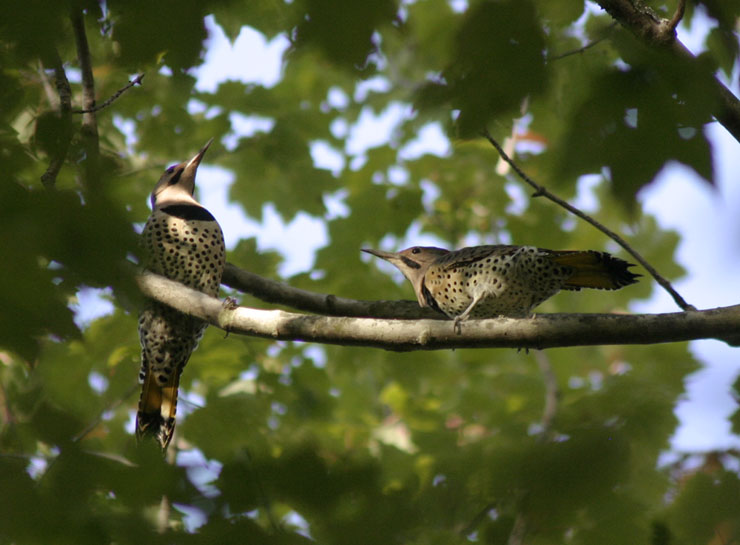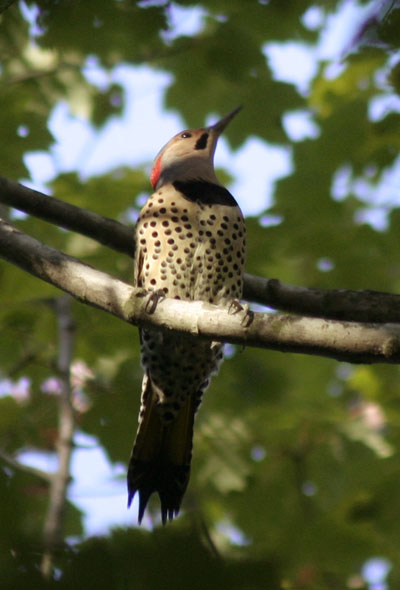
Early this evening, as I spoke on the telephone while standing on my upstairs patio, a “conversation” from the trees across the driveway drew my attention, and I cut the call short. While I couldn’t see anything, some very soft “wheet-a wheet-a” sounds were emanating from quite close by. Naturally, I grabbed the camera and started tracking the sounds, and eventually caught site of the birds seen above.
Common Flickers (Colaptes auratus) are found throughout North America, but tend to be shy, and being woodpeckers, prefer to stay within wooded areas. Their territorial call is a sudden sharp whistle, descending in tone, but what these two were using might best be described as the squeak of someone scrubbing glass, sharp but quiet initial note with a fainter followup, repeated regularly about twice a second and with varying pitch and volume. As they did this, they bobbed and twitched at one another. Since these were both males, as determined by the mustache mark alongside their beaks, I suspect this was a territorial discussion – another photo that I have, unfortunately not sharp enough to show anyone, shows raised feathers along the crest of the head, another dominance display. My best guess right now is that these are siblings from this year’s brood trying to decide who could lay claim to this part of the woods.
What allowed me to get these images was mostly my curiosity at the faint repeated “wheet-a“s, and remaining alert to any movement when searching the area. Their coloration, especially in partially shaded conditions, is very subtle, and you’ll most likely identify them by the flash of white at the base of their tail at the back (what birdwatchers call the “rump”) as they fly from one trunk to another. Shown here perched, they will just as often alight on the trunk itself and remain upright, which is of course their feeding/foraging position.
 Another image that I caught shows off the lovely fawn coloration of their heads a bit more, as well as the red patch at the nape of the neck and the pointed tips of the tail feathers. Most woodpeckers use their tail as a brace and springboard for pecking, so the shafts of those feathers are likely quite strong. The breast feathers, with their spots, are very distinctive even when found by themselves on the floor of the forest. They’re fan-shaped for maximum coverage and heat retention, so rather than each spot belonging to only one feather, every feather has a collection of them – you’re seeing fewer feathers here than you might imagine.
Another image that I caught shows off the lovely fawn coloration of their heads a bit more, as well as the red patch at the nape of the neck and the pointed tips of the tail feathers. Most woodpeckers use their tail as a brace and springboard for pecking, so the shafts of those feathers are likely quite strong. The breast feathers, with their spots, are very distinctive even when found by themselves on the floor of the forest. They’re fan-shaped for maximum coverage and heat retention, so rather than each spot belonging to only one feather, every feather has a collection of them – you’re seeing fewer feathers here than you might imagine.
I have a fruit-and-nut wreath birdfeeder to put up, but that’s hardly a natural setting for photos, so I might start getting creative by breaking it up and forcing the bits into crevices in prime photography areas. This will give woodpeckers and nuthatches something to do and allow me to use the best light and backgrounds, and still get natural-looking images.
One of these days I’ll get a decent sound recording system aimed for outdoor use and start podcasting the neighbors’ conversations. Donations, of course, are gratefully accepted… ;-)



















































